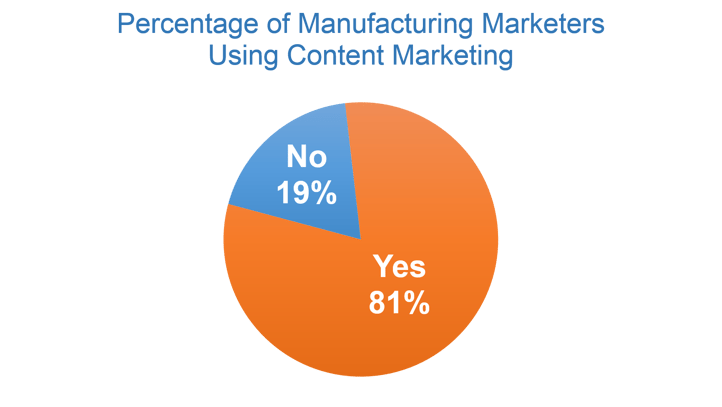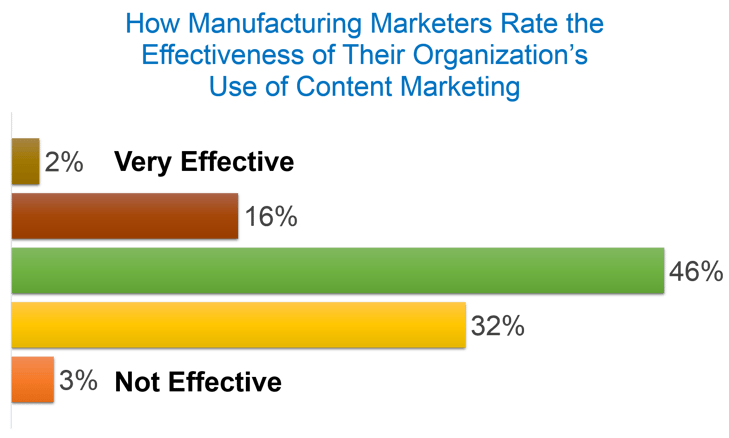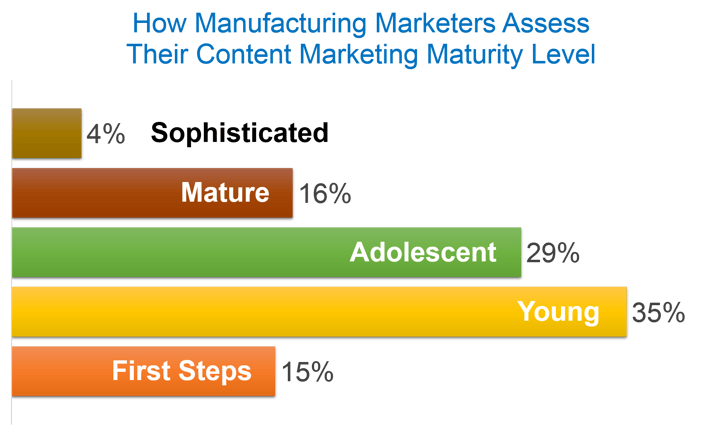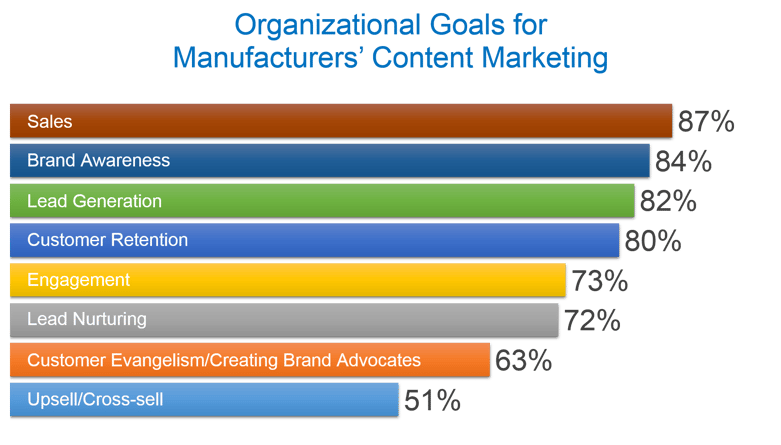This post is authored by Joel Don, ISA's community manager and a social media & content marketing consultant | @joeldon
Manufacturing and industrial marketing have something in common. They focus on building a product and delivering it to the customer. Both want to make sure the  customer comes back for more, since the cost of winning new business generally far exceeds the cost of retaining current customers.
customer comes back for more, since the cost of winning new business generally far exceeds the cost of retaining current customers.
ThertitWeb Presence, but what do these marketers build? A lot of interesting information we nowadays call content. Plus, they have to figure out every which way to deliver it, either digitally or via traditional marketing collateral vehicles. And they have to measure the results. That’s content marketing.
 Source: Content Marketing Institute 2016 Research
Source: Content Marketing Institute 2016 Research
Content marketing for industrial automation and manufacturing businesses is certainly not new. During the “paper chase” era, marketers and public relations pros developed printed success stories, brochures, fact sheets, case studies, white papers, and newsletters aplenty, often complemented by high-quality photos and graphics. Most or all of that has gone digital. The only thing that restricted greater application of video was the ultra-high cost of production. New digital marketing tools have certainly made the design, construction and distribution of words and images a whole lot easier. Low-cost, easy-to-use software and cloud-based content creation tools have virtually eliminated most financial roadblocks, even for producing live action video and animation. We also get a bonus with the digital distribution of content: real-time metrics and ROI is just a click away.
So it shouldn’t come as a surprise that the 2016 B2B Manufacturing Content Marketing Trends research report says 81 percent of manufacturing marketers in North America are leveraging content marketing.
That should be good news, since that figure represents a solid majority of companies leveraging content for marketing outreach. But then there’s another data point from the study that suggests marketers are not fully invested in content marketing. It turns out only 18 percent of B2B manufacturing marketers feel that they are effective at content marketing. That’s a surprising metric when you consider that studies continue to show consumers prefer to get their information from articles and videos rather than advertisements. Content marketing shows customers who you are as an industrial or manufacturing business, which is a more potent sales strategy than simply telling people what you do or make or sell. The selling is in the showing.
 Source: Content Marketing Institute 2016 Research
Source: Content Marketing Institute 2016 Research
Let’s dig a little deeper into the industry research. One of the reasons marketers struggle with questions about the effectiveness of content marketing is reflected in a response to a self-assessment of their content marketing maturity level. Only 20 percent of marketers say they are able to demonstrate ongoing success of their content marketing programs and can justify outcomes with acceptable measurement methodologies. Even though a majority of industrial marketers reported that they have a content marketing strategy, there still seems to be a lack of clarity on how you claim success for your programs.
 Source: Content Marketing Institute 2016 Research
Source: Content Marketing Institute 2016 Research
Interestingly, everyone seems to agree on the primary goal for content marketing. Sales ranks No. 1 followed closely by brand awareness, lead generation, and customer retention and loyalty.
 Source: Content Marketing Institute 2016 Research
Source: Content Marketing Institute 2016 Research
It's about sales, and a lot more
Does content marketing play a role in the sales funnel? Yes. Is content marketing strictly a sales function. No. So perhaps industrial marketers in our multi-dimensional digital era are still largely assessing the value of content marketing from a two-dimensional rubric straight out of the pre-Internet. Manufacture some content, and then generate a sale. Do you really believe there's no other purpose, benefit or goal for content marketing?
I am always surprised when industry professionals view content marketing from a perspective that has not matured to the new “cluetrain” generation of communities and conversations. It's certainly OK to assign sales as the top objective for content marketing. But then the same yardstick should apply to other corporate functions. Accounting, customer service, shipping — they're all about sales. New media strategist David Meerman Scott got fed up with this bottom-line “MBA approach” applied to every nook and cranny of marketing in a famous three-minute rant. It’s worth a listen if you maintain traditional notions about the goals and objectives for your content marketing program. Scott’s point, which has been reinforced by other marketing influencers, does not sidestep the question of ROI and sales. The concept of “ROI” is often misunderstood or not relevant for a marketplace dynamic that is in a constant state of disruption and evolution.
When I worked as a public information officer at the UCLA Medical Center, a local television reporter doing a story asked to shoot video of nurses in the wards. I pointed down a busy corridor filled with people wearing scrubs. He frowned: “But where are the nurses, you know, the white dresses, aprons and the bonnets?” The response from a modern-era nurse: "You're not a reporter; where's your fedora with a press card in the hatband?" The point: the reporter’s objective was simply no longer relevant.

Content marketing misunderstood?
In a previous post, I discussed how content marketing is an important promotional strategy that can contribute to website SEO and deliver many other tangible as well an intangible benefits. Content marketing is an ongoing process for building brand awareness, influencing consumer behavior, reinforcing customer loyalty, attracting new customers and marketing products — without the overt sales pitch. People don't want to be sold; they want to be informed and entertained (on their way to a sale).
Content marketing does not replace sales; it complements every business function that contributes to "the sale." In pre-digital times, we struggled to associate a printed press release or brochure with sales. We used a lot of soft metrics and assumptions. There's certainly more analytics available today, but it's still a challenge to associate a comprehensive content marketing program across multiple distribution channels and social networks with a single sales transaction. Awareness, influence and loyalty marketing are enmeshed in cumulative brand-building strategies that may or may not include a sales overture or direct call to action. Content marketing today is not sales per se; it’s a vital part of the process because it reflects how people want to be sold.
Every company has a different sales process and goals specific to their business model. And there are many things you can measure to assess the value and effectiveness of your content marketing program. Just make sure your metrics are relevant to your objectives.
So in assessing the effectiveness of your content marketing, is your industrial automation business or manufacturing company looking for nurses wearing bonnets or scrubs?




